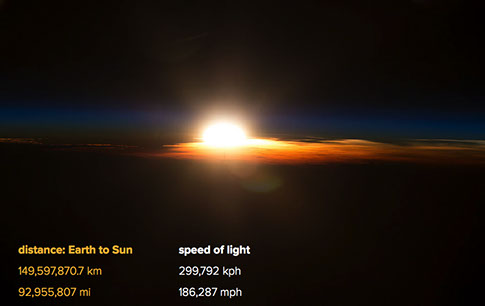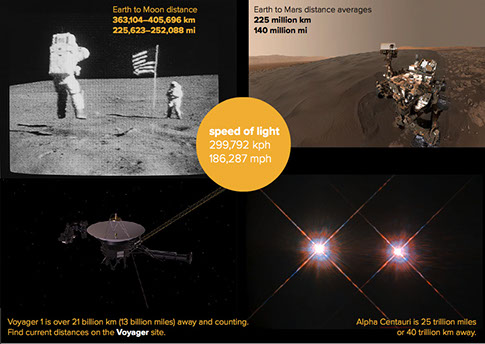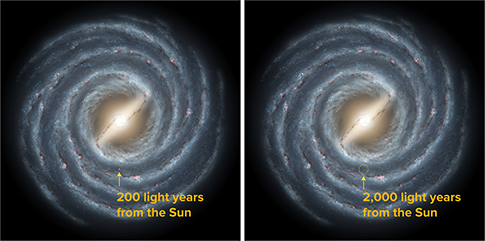SciGen Teacher Dashboard
Flash to Bang
Waves without a Medium
The Electromagnetic Clothesline
Making the Invisible Visible
All-Star Alien Hide and Seek
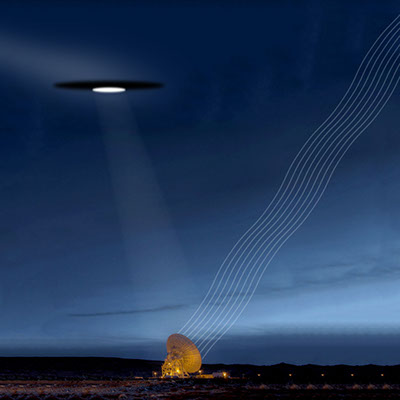 Conversation: All-Star Alien Hide and Seek
Conversation: All-Star Alien Hide and Seek
Duration: Approximately 90 minutes plus optional 30-minute extension
After exploring our place in the universe and learning about SETI (the search for extraterrestrial intelligence), discuss the pros and cons of monitoring and sending messages using different frequencies on the electromagnetic spectrum, usually in the longest wavelengths (such as radio waves).
LEARNING OBJECTIVES
Students use information about the scale of the universe and probability of extraterrestrial life to form and support a scientific argument about the search for intelligent life elsewhere in space. This activity relates to human-made electromagnetic waves as used for communication, both on and near Earth, as well as beyond. Students reinforce their basic understanding that waves can be used for communication purposes and that the speed of light measures up to the size of the universe. Students identify two methods for using electromagnetic waves to communicate. Students analyze pros and cons using reason and evidence to construct an argument for or against attempting to communicate with extraterrestrials (actively or passively). Students use scientific thinking and apply what they learned earlier in the unit to make scientific arguments.
Teacher Tips
- This lesson assumes that students have already explored many of the basic behaviors and terminology of waves. The core of the lesson is using reason to form an opinion about a topic, and at the root of that are questions about how waves travel AND students' values.
- Some students may not respond well to the unfamiliar terminology used when describing waves. Judge whether your students would absorb the material better if you use the word "electromagnetic" or abbreviate it "EM." Calling all EM waves "light waves" is simpler and technically accurate (since all EM waves travel at the speed of light) but may confuse students who will think only of visible light. For more on challenges using text, see the SERP materials on Reading to Learn in Science.
-
Misconceptions alert:
- Many students arrive in the classroom with abstract, science-fiction based views ideas about “light speed.” This lesson includes a discussion of scale that adds a much-needed level of concreteness to such ideas.
- You will be asking your students questions for which science does not yet have answers. Students often regard science as a body of knowledge. Take the opportunity to make clear that science is a method for producing knowledge, not the knowledge itself.
- For students who get very interested in the philosophical and ethical implications of making contact with other species, there are many sci-fi media sources that explore the excitement and risks of communicating with other civilizations, including Carl Sagan's 1985 Contact (made into a 1997 movie starring Jodie Foster) and Ted Chiang's 2002 short story "Story of Your Life" produced as Arrival. See a full list on Wikipedia.
Teacher Tune-ups
Teaching Notes
ACTIVITY OVERVIEW
- Introduce extraterrestrial communication (10 minutes)
- Read the article (20 minutes)
- Optional strategy: Read in Listening Triads (with reading the article)
- Compare scale of the universe vs. speed of light (10 minutes)
- Talk about argument (10 minutes)
- Have the conversation: All-star alien hide or seek? (30 minutes)
- Optional extension: Decode the Arecibo Message (30 minutes)
Introduce extraterrestrial communication (10 minutes)
Display the first slide, on the tab labeled "a word." Ask:
Has anyone ever heard of the word "extraterrestrial"?
Some of your students may have heard the word as a synonym for "alien," as in the movie E.T. the Extra-Terrestrial (1982).
Display the second slide on the tab labeled "break it down." Paraphrase:
Let's break down the word into its parts. The prefix "extra" means "out of" or "beyond" while "terr" is for "Terra," another name for our planet Earth.
The electromagnetic waves traveling across the universe are mainly extraterrestrial.
Display the third slide on the tab labeled "the Universe." Ask:
Are there extraterrestrial civilizations out there in the Universe?
Give the students a few minutes complete a KWL chart individually or to turn and talk in a pair-share. Ask students to share their viewpoints with the class. Student interest here is very high, so as they discuss, interject lightly to provide new information or answer questions based on the slides.
For example, you can display the third slide (on the tab labeled "the Universe") and say something along the lines of:
We live in a galaxy, the Milky Way, that is just one among 100–200 billion galaxies in our universe.
Looking through telescopes like the Hubble that captured this image is like a kind of time travel, in that we're looking at light and radio signals from hundreds of thousands of years ago.
If students wonder how many inhabitable planets there are, display the fourth slide (on the tab labeled "the Milky Way"). Paraphrase:
Our own galaxy, the Milky Way, has about 300 billion stars. Each of those stars could have a planet orbiting within a zone that could sustain life.
If students wonder how likely it is that Earth is the only planet with life, display the fifth slide (on the tab labeled "the odds"). Note: this figure is derived from the Drake equation which multiplies seven different factors together to result in this value. Paraphrase:
Through their calculations, scientists figure that the chances of Earthlings being the only beings ever to develop a civilization at about 1 / 1022 — that is, one in 10 billion trillion.
Put another way, scientists believe there's a 99.9999999999999999999% chance there's another civilization out there.
If students wonder whether we have ever heard from another civilization, display the sixth slide (on the tab labeled "Wow! message"). Paraphrase:
The search for extraterrestrial intelligence is called SETI, pronounced "SET-ee" rhyming with Betty.
Have you ever seen a radio with a tuning knob? It makes a lot of noise between the stations. When we listen to the stars we hear the noise cooked up by the cosmos. There's a lot of background radiation criss-crossing the universe.
For 72 seconds in 1977, Ohio State University's Big Ear radio telescope received what SETI researchers considered the most likely possibility of an alien radio transmission ever seen or heard. The data were so impressive, an astronomer monitoring it wrote "Wow!" next to the printout.
Look at all the numbers around it. It really stood out compared to the usual data coming in. The Wow! Message is like a shape or clear sound suddenly emerging from a chaotic background.
But what could "6EQUJ5" mean, if anything?
In 2017, astronomers finally realized the signal was made by a comet, not an extraterrestrial civilization after all.
Read the article (30 minutes)
In this section, students read an article that considers the pros and cons of SETI.
Paraphrase:
You may have seen movies where people from Earth explore other planetary systems, and where explorers from other planets come to Earth.
The Search for Extraterrestrial Intelligence (SETI) is our primary way of looking for off-Earth civilizations.
We'll read an article that considers a few of the pros and cons of making contact with other societies.
Image credit: NASA/JPL-Caltech Radio telescope in the Mojave Desert, similar to the one used in Tromsø, Norway.
We just beamed a signal at space aliens. Was that a bad idea?
In a valley near Tromsø, Norway, an antenna has just transmitted a radio signal to potential alien listeners.
This isn’t the usual approach to the Search for Extraterrestrial Intelligence (SETI). Usually, SETI scientists use such antennas to listen, not to speak. They hope to hear a signal from so far away that they would have been broadcast tens, hundreds, or even thousands of years ago. So far, no luck.
The Tromsø transmission is an example of “active” SETI. The idea is simple: send a signal that would alert aliens we’re here, and listen for a reply. The Tromsø broadcast was beamed to one of the nearest star systems believed to have an Earth-like planet. The target is located 12 light-years from our solar system. Since radio waves travel at the speed of light, we’ll have to wait more than two decades before looking for a reply.
While the broadcast from Norway is unlikely to provoke a response by any extraterrestrials, you can be sure it will provoke plenty of Earthlings.
Why is messaging aliens such an issue? To begin with, what do you say to someone you’ve never met, and who’s a member of a different species? Do we tell aliens that we engage in war, threaten our environment, and chow down on other critters? More importantly, could sending signals endanger our whole species? Suppose aliens do exist, and they’re unfriendly. If we draw attention to ourselves with a broadcast — no matter what its content — they might respond with a fleet of interstellar missiles to take us out. Bummer.
Would aliens really do that? Why should we take the chance? Two reasons:
- We’re already making noise. We’ve been broadcasting into space with high-powered transmitters (radar and TV) for more than a half-century now. Sure, those signals aren’t easy to detect out there in space — at least for someone with our level of technology. But for a society a century or two ahead of us, it would be trivial. And if the aliens are not at least that advanced, they simply won’t have those interstellar missiles.
- We shouldn’t silence science. We have other needs for radio signals. To locate comets headed our way from the outer regions of our solar system, for example, we will need to use radars, ones much more powerful than the ones we have today.
Let’s face it, it’s impossible to know what our great-great-grandchildren will find interesting or worthwhile to do.
Personally, I hope the aliens get in touch.
Adapted from "We just beamed a signal at space aliens. Was that a bad idea?” by SETI’s Senior Astronomer Seth Shostak for NBCNews MACH (November 2017).
Optional strategy: Read in Listening Triads (with reading the article)
Listening Triads are an easy strategy for structuring small group reading and discussion. They give students practice in active listening and monitoring their own comprehension as they read.
The questioner asks questions about the text. For example:
- What does that mean?
- Why do you think that is?
- Can you explain what's similar/different about _____?
The explainer uses the text to attempt to answer the questions. For example:
- I think it means that...
- I think what the text says is true/false because...
- This is similar to/different from _____ because...
The recorder keeps the group on-task and records notes on the questions and their answers.
Questioners
Ask questions about the text.What does that mean?Why do you think that is?Can you explain what's similar/different about _____? Explainers
Try to answer the questions using the text.I think it means that...I think what the text says is true/false because...This is similar to/different from _____ because... Recorders
Keep your group
on-task.
Take notes on the questions and their answers.
Compare scale of the universe vs. speed of light (10 minutes)
Consider with your students the distance that human-made radio signals have travelled at the speed of light (as all electromagnetic waves do).
Show slide 1 (the Sun photographed from Earth's orbit). Ask students to consider the vastness of the universe. Ask them:
How long does it take for light to get to Earth from the Sun?
How do we use distance and speed to calculate travel time?
Calculate the time it takes for light to travel from the Sun to the Earth.
Answer: The Sun is 150 million km (or 93 million miles) from Earth. Light travels at a speed of 299,792 kilometers (or 186,287 miles) per second. It takes 499 seconds for light to travel from the Sun to the Earth.
Ask:
How long would it take a radio wave from our local radio station to reach the Sun?
Possible answer:
Light and radio waves travel at the same speed, so it'd take 499 seconds (or about 8.3 minutes) for a radio wave to reach the Sun from Earth.
Show slide 2 (with images of Moon landing, Mars, Voyager, and Alpha Centauri) to give students a sense of the vastness of the galaxy. Scale up with questions:
- How long did we wait for the transmissions from the Apollo missions on the Moon?
- How long would NASA wait to hear a reply from a rover on Mars?
-
How long would NASA wait to hear a signal from the Voyager craft?
- Fun fact: Voyager is carrying a golden record and travels about than 17,000 times slower than the speed of light.
- How long does it take for light to arrive from Alpha Centauri?
Extension: a nice visualization can be found at Distance to Mars.
One of the points made by the writer of the article is that our electromagnetic signals have inadvertently been escaping Earth and going out into the universe for more than 50 years. Think of broadcasts such as baseball games and music on the radio or television broadcasts. Radio was invented in 1895, and the signals haven't been strong enough to travel any distance beyond Earth until a TV broadcast of the Olympics in the early 1930s.
Show Slide 3 (Milky Way with the captions "200 light years from the Sun" and "2,000 light years from the Sun.") This slide shows a diagram of what SETI scientists call "the radio bubble" since the transmissions leave Earth in three dimensions, like a sphere.
Paraphrase:
Nothing can travel faster than the speed of light.
Remember the picture of the Milky Way? It is 100,000 light years across. How long would it take for any electromagnetic waves to get across our galaxy?
Intended answer:
It would take any electromagnetic waves 100,000 years to get across our galaxy.
Continue paraphrasing:
TV and radio signals bounce around Earth but also beam out into space as electromagnetic waves.
The first strong radio signals on Earth were sent only a little over two centuries ago. On a cosmic scale, they haven't left our backyard. This tiny yellow dot shows how far our accidental signals have reached since we invented radio in the 19th century. The small circle on the right shows how far our signal would have reached if we'd invented radio in the years before 1 BCE. What was happening then? If a civilization were transmitting radio signals then, would we have heard them?
Intended answer:
Two thousand years ago was the time of Roman rule in Europe and the Han dynasty in China. Radio technology was not yet invented, so we would not have heard their signals.
Point out that a radio bubble 10 or even 20 times as big is comparatively small when compared to the size of the Milky Way, and ours is just one of many galaxies in the universe.
Conversation: Hide or seek? (30 minutes)
Now lead the class in a conversation about whether humankind should transmit messages, or just listen for ones we might receive, or neither. If you do not feel comfortable running a discussion, this question could easily be used as a writing prompt instead of a discussion prompt.
Students may prefer to take one of the three viewpoints as their own. If you expect students will not divide evenly, you may consider randomly assigning them roles or sides in the debate.
Explain to students:
It is your job to argue well for the position you choose (or are assigned). Use information on this page as well as information from the prior sessions. It is also a great time to use your previous notes about waves and the unit's focus words.
For ideas about how to run a class discussion, click here. Consider printing out these Talk Move tips. Take a look at the discussion rubric.
End this lesson with a general discussion during which students share their own comments and raise their own questions.
Image Credit: The Very Large Array of Radio Telescopes by Dave Finley, AUI, NRAO, NSF. NASA Explanation: Each of the 27 radio telescopes in the Very Large Array (VLA) is the size of a house and can be moved on train tracks. The VLA has been used to discover water on planet Mercury, radio-bright coronae around ordinary stars, micro-quasars in our galaxy, gravitationally-induced Einstein rings around distant galaxies, and radio counterparts to cosmologically distant gamma-ray bursts.
Should we transmit messages,
or just listen for ones we might receive,
or neither?
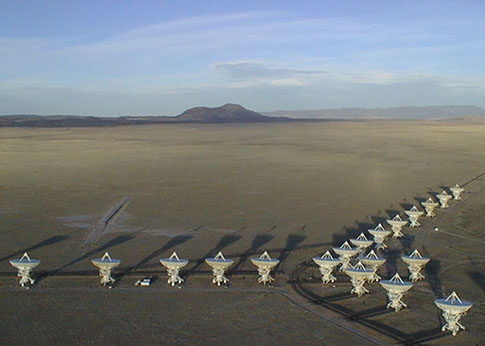
In your argument, you may want to use some of the words you've
encountered while learning about waves, such as:
electromagnetic • spectrum • visible • radiation
ultraviolet • infrared • radio • microwave • transmission
medium • wavelength • frequency • analog • digital
Here are some ways you can start your sentences:
- One reason for ………… is...
- Another reason is...
- Additionally…
- However, on the other hand...
- A reason not…
- Furthermore, we should not because…
Optional extension: Decode the Arecibo Message (30 minutes)
This extension gives students a chance to see a real message sent to possible extraterrestrial intelligent life. There is a lot to digest.
Another famous active SETI project is 1974's Arecibo message. It contains three minutes of binary data beamed to a specific location 25,000 light years away.
The binary code is shown (the string of 1s and 0s). The code represents 1,679 pixels in a 23x73 array.
Image Credit: Frank Drake (UCSC) et al., Arecibo Observatory (Cornell, NAIC)
If you'd like, you can give time for students to reconstruct the Arecibo message on the graph paper in the printable below. They may not gain much from this task, however.
Look at the black and white image together. Ask students to figure out what they are looking at before you give them clues about what they're seeing. Ask:
Can you make sense of Arecibo's encoded message to the universe?
Engage students in a conversation about what they see in the image, if anything. The images are fairly abstract, so you will want to point out parts that are supposed to be specific things. You can do this by projecting the image onto a white board and coloring in squares.
 The pixelated images represent the numbers 1–10 (top of image); atomic numbers for five common elements (pink at the top) and formulas for sugars and bases (green); DNA (blue); the human form (red); Earth's location in the Solar System (line of white just below the human) indicating which of the planets sent the message (slightly higher third dot); and the radio telescope that sent the message (pink at the bottom).
The pixelated images represent the numbers 1–10 (top of image); atomic numbers for five common elements (pink at the top) and formulas for sugars and bases (green); DNA (blue); the human form (red); Earth's location in the Solar System (line of white just below the human) indicating which of the planets sent the message (slightly higher third dot); and the radio telescope that sent the message (pink at the bottom).
End the session by asking students what they would send in a message to other civilizations.
This extension is a chance to see how well the students can communicate their reasons for what they read in the message and what they would send in a message. Give students time and space to discuss and design their message, or to write about what they would send and why.
TERC has an interesting activity related to the Arecibo message in its Astrobiology Afterschool curriculum: Activity 1.2, "Is Anybody Out There?"
00000010101010000000000
00101000001010000000100
10001000100010010110010
10101010101010100100100
00000000000000000000000
00000000000011000000000
00000000001101000000000
00000000001101000000000
00000000010101000000000
00000000011111000000000
00000000000000000000000
11000011100011000011000
10000000000000110010000
11010001100011000011010
11111011111011111011111
00000000000000000000000
00010000000000000000010
00000000000000000000000
00001000000000000000001
11111000000000000011111
00000000000000000000000
11000011000011100011000
10000000100000000010000
11010000110001110011010
11111011111011111011111
00000000000000000000000
00010000001100000000010
00000000001100000000000
00001000001100000000001
11111000001100000011111
00000000001100000000000
00100000000100000000100
00010000001100000001000
00001100001100000010000
00000011000100001100000
00000000001100110000000
00000011000100001100000
00001100001100000010000
00010000001000000001000
00100000001100000000100
01000000001100000000100
01000000000100000001000
00100000001000000010000
00010000000000001100000
00001100000000110000000
00100011101011000000000
00100000001000000000000
00100000111110000000000
00100001011101001011011
00000010011100100111111
10111000011100000110111
00000000010100000111011
00100000010100000111111
00100000010100000110000
00100000110110000000000
00000000000000000000000
00111000001000000000000
00111010100010101010101
00111000000000101010100
00000000000000101000000
00000000111110000000000
00000011111111100000000
00001110000000111000000
00011000000000001100000
00110100000000010110000
01100110000000110011000
01000101000001010001000
01000100100010010001000
00000100010100010000000
00000100001000010000000
00000100000000010000000
00000001001010000000000
01111001111101001111000

BETA Version - Please send comments and corrections to info@serpinstitute.org

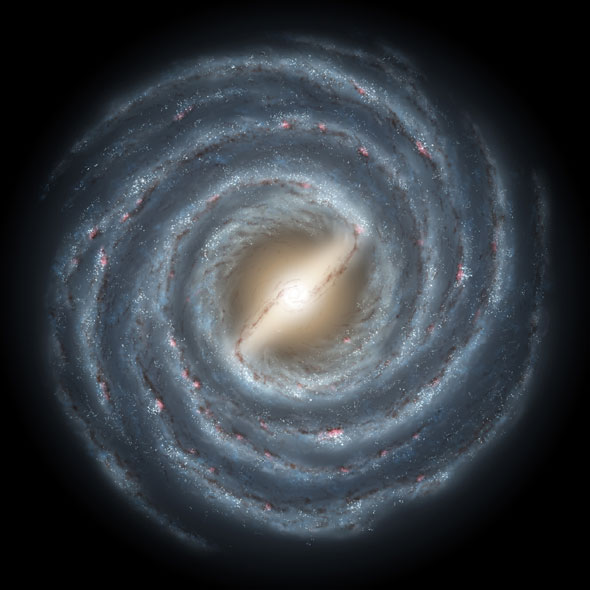
485x274.jpg?crc=97860527)


